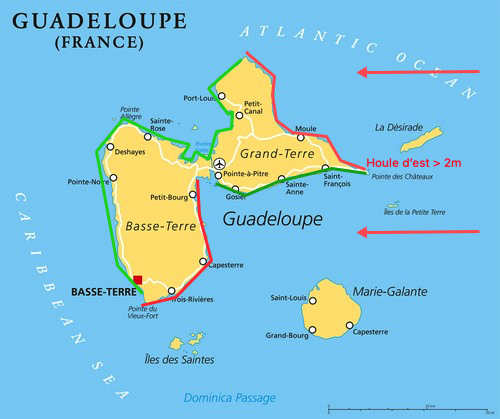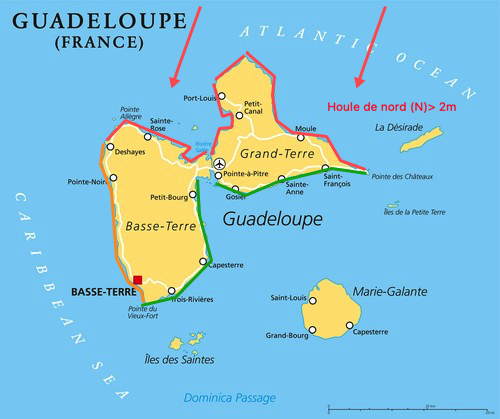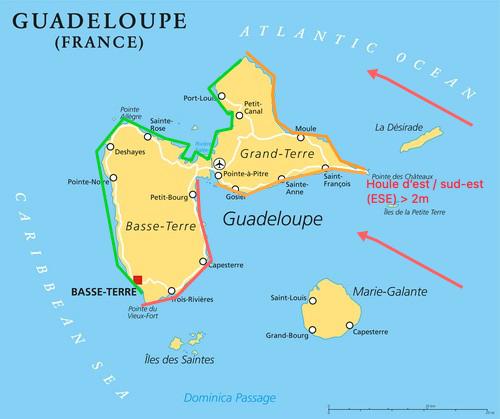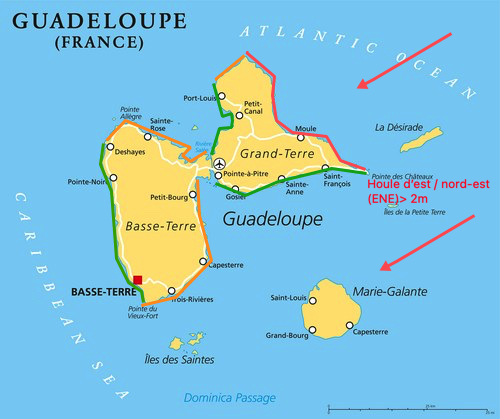What's the weather like today in Guadeloupe ?
Would you like to have the weather forecast for the whole year ?
Easy. Nice weather with risk of showers !
This is the general case that is often verified. Yes, all year round the thermometer fluctuates a few degrees around 30°C during the day, and 22°C at night. However, you should know that an island is particularly vulnerable to wind, rain and swell conditions in particular. But insularity also allows you to seek better conditions on the opposite side of the exposed coasts. But then, how do you plan your outings to go to the beaches of Guadeloupe according to the weather.
Weather in Guadeloupe : where to find out ?
First of all you need to find out about the weather. To consult the weather forecast, there are a plethora of sites and mobile applications. First of all, the little app on the phone that tells you the weather, honestly, is an unreliable gadget, or at least insufficient. Specialized sites for coastal weather like Windguru or Windy are much more precise, and often used by surfers and windsurfers. But you have to be a little used to reading weather files that are sometimes a little technical.
My advice is to watch the weather forecast on the local TV channel Guadeloupe 1ère. It's at 7:25 p.m., just before the 7:30 p.m. local news. The strength and direction of the swell and wind, the main parameters to take into account, are clearly shown with arrows and will allow you to decide on your program for the next day during dinner or an aperitif.
Understanding the swell to plan your outings
You should know that the dominant swell and wind in the Antilles generally come from the east (from right to left if you prefer), varying between East / North-East and East / South-East, and sometimes the swell comes North. Except in exceptional cases such as a cyclone in the Caribbean basin, the swell can then come from the west or the south, but this is extremely rare. This is why you will only see in this article the maps of the 4 most frequent cases
If you are looking for calm seas and the swell is greater than 1.50 to 2 meters, you will need to go to the opposite side of the exposed coasts. The maps below show the "bathability" of the coasts depending on the direction of the swell. Of course this is not an exact science, but by seeing the maps you will easily understand the logic which will allow you to choose your swimming spots. Surfers will of course look for coastal areas in red.
Beaches Guadeloupe Saint François
The East is the sector from which the swell and wind come most frequently in the Antilles, all year round. It is also the orientation that allows you to make the most of the beaches of Guadeloupe. The southern coast of Grande Terre being protected by a coral reef, the beaches are almost always passable, just like the Leeward Coast of Basse Terre which, as its name indicates, is located in the lee of the island which thus protects the entire west coast. The large marine cul de sac, the part located at the top between the two wings of the butterfly, is also protected and calm. You are therefore spoiled for choice by east swell.

Beaches Deshaies Guadeloupe : when to avoid going there ?
The beaches of Deshaies are magnificent and calm, except for swells coming from the north. Especially if you have young children, the coasts of Deshaies, which are not protected by a coral reef, can quickly become dangerous when the swell comes from the North, and rough with east/north-east swells. Take this into account and modify your program if you plan to go to Deshaies. Instead, wait until the swell has returned to the East, or at least East/North East. The risk of drowning exists for the less vigilant, but more frequently we see fractured collarbones or sprains. Be careful and, friendly advice, when you are in the water in a slightly rough sea, always look towards the sea to see the waves coming. Otherwise, while you're saying hello to your friends on the beach, a wave surprises you from behind and can sweep you away violently. If you are more of an aquatic nature and don't mind swimming in rough seas, know that you won't be a match for a big roller, but you can dive under it just before the wave crashes and come out again. the other side. This is the technique used by surfers to reposition themselves behind the wave.
A north swell occurs occasionally, however. It generally lasts 2 to 3 days, before returning further east.

Beaches Guadeloupe Gosier
Towards the end of the tourist season, from April onwards, the dominant swell frequently comes from the East/South-East. The sides facing south are then more exposed. The south coast of the mainland, known as "the riviera", being largely protected by a coral reef, most of the beaches remain passable, but still require a little vigilance. If the wind also comes from this direction, it also sweeps directly across the coast, which is rather pleasant when the wind is less than 30 km/h. Beyond that, the best conditions are undoubtedly on the north side of the island.

Beaches Guadeloupe Le Moule
The North/North-East swell is more frequent from December to April. Vigilance is then required in the North Basse Terre, the windward coast of Grande Terre. At Le Moule it is then that you will see the most water surfing on the city's famous spot.

The advantage of central accommodation
Being housed in the center of the island allows you to go wherever you want on the best beaches in Guadeloupe. Jaden Kreyol, you are 30' away from the beaches of Deshaies, Bouillante and Gosier, 50' from Port Louis or Saint François. Reasonable travel times which put all the sites of interest in Guadeloupe within driving distance.
Dangerous beaches in Guadeloupe